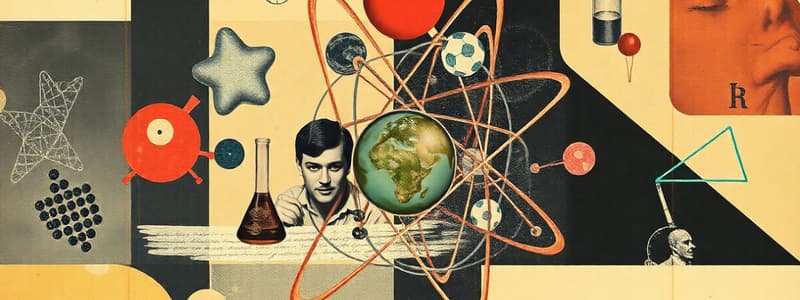Podcast
Questions and Answers
What does Dalton's Atomic Theory primarily describe about atoms?
What does Dalton's Atomic Theory primarily describe about atoms?
- Atoms can be created and destroyed during a chemical reaction.
- Atoms of the same element are identical in properties. (correct)
- Atoms are water molecules that combine to form compounds.
- Atoms of different elements are identical in all properties.
What is a key feature of Thomson's atomic model?
What is a key feature of Thomson's atomic model?
- Atoms form a nucleus without any charged particles.
- Electrons are embedded within a positively charged sphere. (correct)
- Atoms contain only protons and electrons.
- Atoms are indivisible spheres.
Which of the following is a characteristic of neutrons?
Which of the following is a characteristic of neutrons?
- They have a positive charge.
- They are neutral particles in the nucleus. (correct)
- They are negatively charged particles.
- They are found outside the nucleus.
What does the nucleus of an atom contain?
What does the nucleus of an atom contain?
How do isotopes differ from each other?
How do isotopes differ from each other?
Flashcards are hidden until you start studying
Study Notes
Atomic Models
- Dalton's Atomic Theory was a pivotal scientific advancement.
- John Dalton proposed this theory, which explained the structure of matter based on experimental observations.
- Dalton's Theory highlights that matter is composed of indivisible atoms.
- Atoms of the same element are identical in properties according to Dalton.
- Atoms combine in simple whole-number ratios to form compounds, as Dalton stated.
- Atoms of different elements combine to form compounds, according to Dalton.
Visual Representations of Atomic Structure
- Dalton's Model (1807): This early model portrays an atom as a solid sphere.
- Thomson's Model (1897): This model represents an atom as a sphere embedded with positively charged particles, known as electrons.
Key Concepts
- Atoms are the basic building blocks of matter.
- An Atomic Model is a visual representation of an atom's structure.
- Dalton's Model represents a simple sphere-shaped atom.
- Thomson's Model envisions a sphere-shaped atom with negatively charged particles embedded within a positively charged sphere.
- A Cathode Ray Tube was an essential tool used in experiments to investigate atomic structure.
- Alpha Particles, which are positively charged, were used in experiments to further explore atomic structure.
- Rutherford's Nuclear Model is a significant improvement on previous atomic models.
- Neutrons are neutral particles found within the atom's nucleus.
- The Nucleus is the central part of an atom, containing protons and neutrons.
- Isotopes are atoms of the same element but with different numbers of neutrons.
- Radioactive Isotopes are isotopes that undergo radioactive decay.
Studying That Suits You
Use AI to generate personalized quizzes and flashcards to suit your learning preferences.




